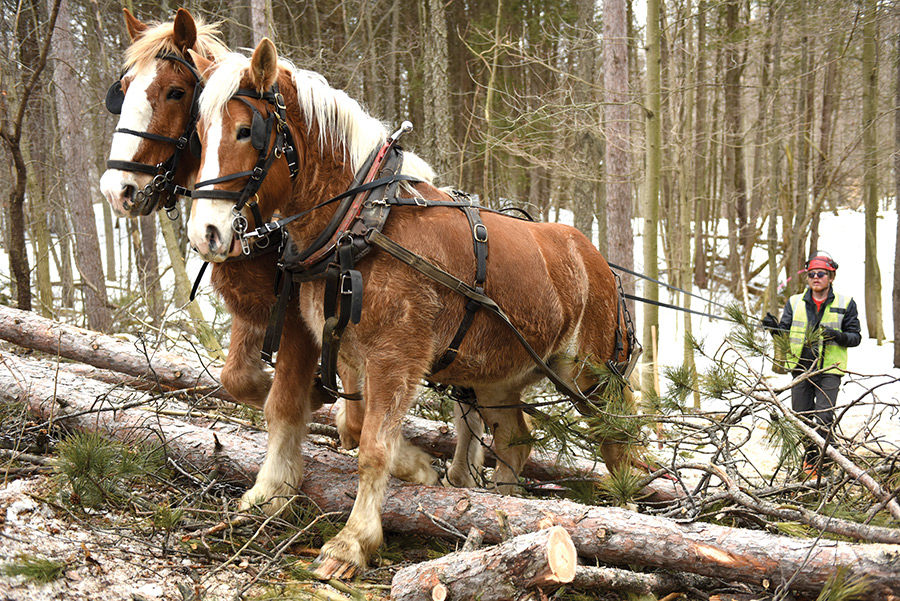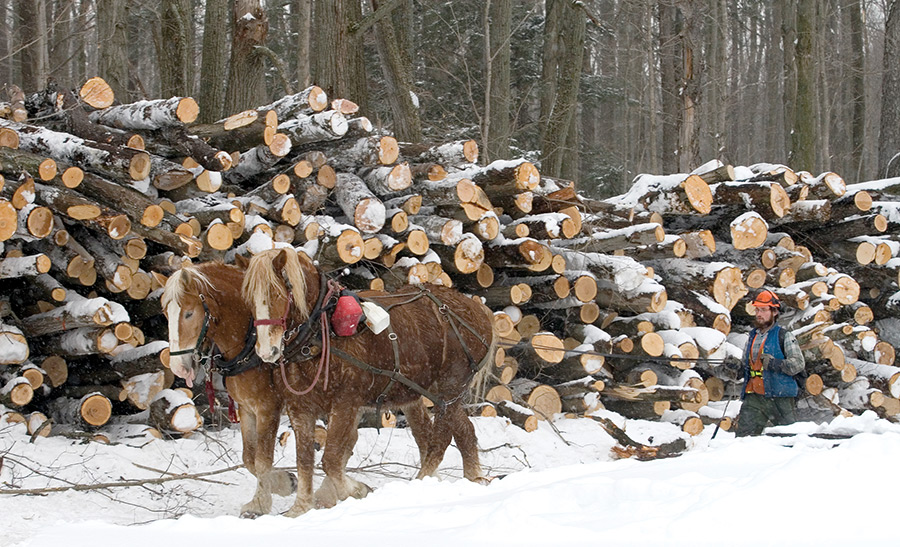WELLINGTON COUNTY – Horses have been hauling logs out of woodlands in Ontario since this area was settled and winter provided the most ideal conditions.
Snow and ice helped to skid the logs along and waterways were used to transport logs out in the spring thaw.
Logging was traditionally a “winter job” because loggers and horses did not have to contend with bugs and heat, and the same animals were used for farming or transportation during other times of the year.
Today, logging and woodlot management takes place year round and incorporates a range of forestry skills, mechanized equipment and occasionally, a team of heavy horses.
Horses have the ability to move in and around sensitive areas, can reduce the eco-footprint of logging and are sometimes preferred by landowners. Horses allow foresters access to forest stands that are across waterways and into places where larger mechanical equipment cannot go.

Working together – Toby Parker drives logging horse team Buttercup and Billy.
Photo by Chris Pincinetti, County of Wellington
Last winter, the County of Wellington worked with Bartram Woodlands at the Little Tract in Puslinch to do forest management. They used a team of logging horses to help lessen the eco-footprint.
Over a six-week period, Bartram and his crew worked with Billy and Buttercup, a Belgian-cross horse team owned and driven by Greg and Toby Parker of Puslinch. These gentle giants have been trained to stand steady when a chainsaw roars to life.
The Little Tract is home to the County of Wellington’s Green Legacy Program buildings, includes 160,000 seedlings and 10,000 saplings, outdoor education trails and is well-used by the entire community.
It is also home to salamanders and other sensitive eco-systems and so it was key that tree removal created as little disturbance as possible.
“The horses love to work. It’s nice to watch; it is a slow, gentle process,” said Alison Morrison, a certified arborist and coordinator of Green Legacy.
Pulling logs out is thirsty work. Each horse requires five to 10 gallons of water per day. Heavy horses weigh between 1,700 and 2,200 pounds and eat one bale of good quality hay each day, plus a grain supplement.
On the job site, horses often also carry in their own food and water. A typical day for a horse logger includes getting up in the dark, feeding the horses, trailering to the work site, tacking up the horses and then hauling trees as needed, to the landing point (pick up area).
It can also involve clearing a trail in to where the trees will be cut. The horses need a break at lunch, when they are given a large helping of hay and grain to refuel. At the end of the afternoon, the horses need to be trailered back home.
Breeds commonly used for horse logging include Belgians, Clydesdales, Percherons, Canadians and other cross-bred varieties. These horses are known for their strength and willing attitude and they have a long association with people.
Traditionally, logging with horses was learned while growing up on a farm and it was a skill that was passed down within families. While this is still done within our Mennonite and Amish communities, there are fewer people throughout Ontario working with horses.
The economics of logging with horses includes pros and cons. Horses are less expensive to move and operate compared to large equipment. Most forestry operations use specialized machines to move logs, which comes with a large up-front capital expenditure.
While horses are initially less expensive than skid steers, they do require care and feeding every day, even if they are not on the job site. A healthy, well-managed forest can be harvested in a sustainable manner about every 15 to 20 years; restorative forestry can increase logging profits and selective cutting can improve tree diversity.
Logging with horses connects people to their forests in a way that machines cannot and the benefits to good land stewardship cannot be measured in dollars and cents.
The Ontario Professional Foresters Association promotes sustainable woodlot management; its website has a list of foresters who offer horse logging services.
Art Shannon introduced Bartram’s and the Parker Team to horse logging about 20 years ago, and logged with horses himself for over 40 years. Shannon, a former teacher of Horse Logging at Fleming College’s Forestry program (Peterborough), grew up with horses and is a certified forester.
Shannon used horses to cut and clear ash trees for Erin land owner Faith Kent a few years ago. Kent, a life-long horsewoman, said, “It was amazing to watch, when a 60-foot ash tree crashed to the ground; Art’s team, who were not tied off, didn’t even flinch.”
Shannon has a practical outlook and says: “If done properly, horse logging can be a win/win/win for the landowner, the logging company and the horse owner.
“However, it is a very specific skill set, and it is important to understand that it takes the right combination of tree skills, horsemanship and mechanized equipment to make it a viable business.”
He advises those interested in logging with horses to “get a solid education and experience with tree cutting first, then find out about horses – not the other way around.”
Shannon, now retired, says he still gets at least one call a month asking about horses and logging. He and his last team are featured in a new film called Workhorse by director Cliff Caines, and cinematographer Ryan Randall.
The horse logging with Art Shannon was filmed at an Erin farm. Workhorse premieres on March 3 online at the Kingston Film Festival and is an introspective look at how heavy horses are used for logging, farming and horse pulling.
When Shannon retired, his horse team didn’t. He gifted his team to a young logger who was keen on logging with horses. This was his way of giving back to the industry.
Horse logging is heavy, hard work, often done during the cold days of winter. So why do foresters who have access to mechanized equipment still do it?
“There is nothing like pulling logs out with horses, it is a beautiful thing to do,” says Dave Bartram.




